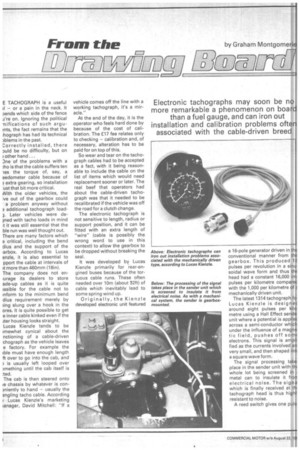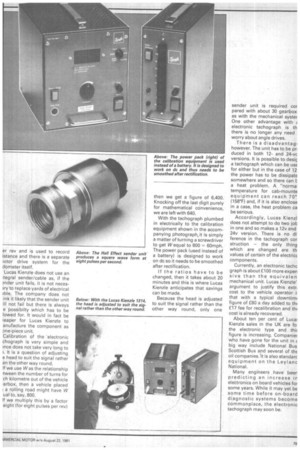Electronic tachographs may soon be n more remarkable a phenomenon
Page 56

Page 57

If you've noticed an error in this article please click here to report it so we can fix it.
on boa than a fuel gauge, and can iron out installation and calibration problems often associated with the cable-driven breed
E TACHOGRAPH is a useful )1 — or a pain in the neck. It aends which side of the fence J're on. Ignoring the political mifications of such argu)nts, the fact remains that the :hograph has had its technical )blems in the past.
Correctly installed, there DuId be no difficulty, but on ) other hand ...
Dne of the problems with a :ho is that the cable suffers ten les the torque of, say, a eedometer cable because of extra gearing, so installation ust that bit more critical.
Nith the older vehicles, the lye out of the gearbox could
a problem anyway without 3 additional tachograph load). Later vehicles were deIned with tacho loads in mind It it was still essential that the ble run was well thought out. There are many factors which a critical, including the bend dius and the support of the larbox. According to Lucas enzle, it is also essential to pport the cable at intervals of )t more than 460mm (18m).
The company does not enurage its dealers to store ade-up cables as it is quite )ssible for the cable not to inform to the minimum bend dius requirement merely by )ing slung over a hook in the ores. It is quite possible to get e inner cable kinked even if the Ater housing looks straight.
Lucas Kienzle tends to be )mewhat cynical about the nctioning of a cable-driven chograph as the vehicle leaves e factory. For example the ible must have enough length ft over to go into the cab, and ) is usually left looped over )mething until the cab itself is :ted.
The cab is then steered onto le chassis by whatever is conaniently to hand — usually the angling tacho cable. According ) Lucas Kienzle's marketing tanager, David Mitchell: "If a vehicle comes off the line with a working tachograph, it's a miracle."
At the end of the day, it is the operator who feels hard done by because of the cost of calibration. The £17 fee relates only to checking — calibration and, of necessary, alteration has to be paid for on top of this.
So wear and tear on the tachograph cables had to be accepted as a fact, with it being reasonable to include the cable on the list of items which would need replacement sooner or later. The real beef that operators had about the cable-driven tachograph was that it needed to be recalibrated if the vehicle was off the road for a clutch change.
The electronic tachograph is not sensitive to length, radius or support position, and it can be fitted with an extra length of "wire" (cable is possibly the wrong word to use in this context) to allow the gearbox to be dropped without breaking the seal.
It was developed by Lucas Kienzle primarily for rear-engined buses because of the tortuous cable runs. These often needed over 10m (about 32ft) of cable which inevitably lead to some spring wind up.
Originally, the Kienzle developed electronic unit featured a 16-pole generator driven in conventional manner from gearbox. This produced pulses per revolution in a si soidal wave form and thus head had a constant 16,000 pulses per kilometre compa with the 1,000 per kilometre mechanically driven unit.
The latest 1314 tachograph Lucas Kienzle is designle around eight pulses per k metre using a Hall Effect sen unit where a potential is app across a semi-conductor wh under the influence of a ma tic field, pushes off so electrons. This signal is a fled as the currents involved very small, and then shaped a square wave form.
The signal processing t place in the sender unit with whole lot being screened i metal can to insulate it f electrical noise. The sig which is finally received at tachograph head is thus hi resistant to noise.
A reed switch gives one p er rev and is used to record istance and there is a separate rotor drive system for the dometer itself.
Lucas Kienzle does not use an tegral sender/cable as, if the 3nder unit fails, it is not necesrry to replace yards of electrical 3ble, The company does not ink it likely that the sender unit ill not fail but there is always e possibilty which has to be lowed for. It would in fact be leaper for Lucas Kienzle to anufacture the component as one-piece unit.
Calibration of the "electronic chograph is very simple and nce does not take very long to r. It is a question of adjusting e head to suit the signal rather an the other way round.
If we use Was the relationship tween the number of turns for ch kilometre out of the vehicle arbox, then a vehicle placed a rolling road might have W ual to, say, 800.
If we multiply this by a factor eight (for eight pulses per rev) then we get a figure of 6,400. Knocking off the last digit purely for mathematical convenience, we are left with 640.
With the tachograph plumbed in electrically to the calibration equipment shown in the accompanying photograph, it is simply a matter of turning a screwdriver to get W equal to 800 — 60mph. The power pack (used instead of a battery) is designed to work on dc so it needs to be smoothed after rectification.
If the ratios have to be changed, then it takes about 20 minutes and this is where Lucas Kienzle anticipates that savings can be made.
Because the head is adjusted to suit the signal rather than the other way round, only one
sender unit is required cor pared with about 30 gearbox, as with the mechanical syster One other advantage with electronic tachograph is th there is no longer any need worry about angle drives.
There is a disadvantag, however. The unit has to be pr, duced in both 12and 24-vc versions. It is possible to desic a tachograph which can be USE for either but in the case of 12 the power has to be dissipate somewhere and so there can b a heat problem. A "norma temperature for cab-mounte equipment can reach 70° (158°F) and, if it is also enclose in a case, the heat problem ca be serious.
Accordingly, Lucas Kienzl does not attempt to do two job in one and so makes a 12v and 24v version. There is no di ference in the tachograph cor struction — the only thing which are changed are th values of certain of the electric components.
Currently, an electronic tache graph is about £100 more expen sive than the equivalen mechanical unit. Lucas Kienzle' argument to justify this extr, cost to the vehicle operator that with a typical downtirm figure of £80 a day added to th( £17 fee for recalibration and th( cost is already recovered.
About ten per cent of Luca: Kienzle sales in the UK are fo the electronic type and thi: figure is increasing. Companie: who have gone for the unit in E big way include National Bus Scottish Bus and several of thE oil companies. It is also standarc equipment on the Leylanc National.
Many engineers have beer predicting an increase in electronics on board vehicles for some years. While it may yet be some time before on-board diagnostic systems become commonplace, the electronic tachograph may soon he.




























































